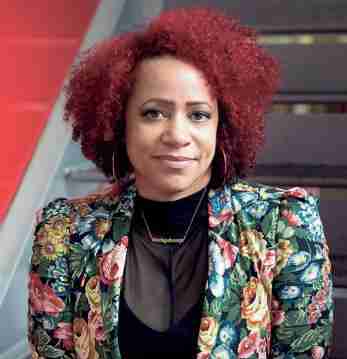When legendary journalist, reporter, talk show host and broadcast producer Barbara Walters died last year, news of her passing spread across social media and the news industry.
Tributes poured in from White and Black women journalists alike in honor of her groundbreaking accomplishments that helped open doors in the field. African American women journalists such as Oprah Winfrey, Tamron Hall, Gayle King and Robin Roberts were among the many who celebrated Walters’ trailblazing career and attributed theirs’ to the late media icon.
The accolades for Walters are many in the narrow hallways for women and rightfully so.
But overlooked and bypassed in those same hallways are the transcendant Ida B. Wells and other Black women in journalism: their history and contributions born out of the desire to heed the call to social and political activism, to use their voices to journal the climate of Black America.
The groundbreaking reportage of Nikole Hannah-Jones and the “1619 Project” is a direct link to Black women journalists such as Josephine St. Pierre Ruffin, Gertrude Bustill Mossell and Mary Ann Shadd Cary.
Let’s journey back in time for Women’s History Month, and remember these trailblazing Black women journalists.
The first Black woman newspaper publisher in North America was Mary Ann Shadd Cary. Born in Wilmington, Del. in 1823 to free Black parents who were not only fierce abolitionists, but used their home to hide runaway slaves.
Shadd was educated in the Quaker school system who eventually traveled the country teaching in all-Black schools.
She picked up the activism of her parents with passion and considered that free Blacks had an obligation to become educated for the betterment of the race and engage tirelessly to end slavery.
She perceived the Black church as failing in its responsibilities, so she put the largest in the country, the African Methodist Episcopal Church, on blast in a scathing 1849 pamphlet that was described as speaking “too much truth.” It was the beginning of a journalism career that often found Shadd at odds with male figures in the movement who considered her “a very intelligent young lady, and peculiarly eccentric.”
With the passing of the Fugitive Slave Act into law in 1850, Shadd moved to Canada with other family members, and published her second pamphlet, “Notes On Canada West,” in which she encouraged Black Americans to emigrate to Canada for opportunities and freedom.
In 1853, Shadd decided that pamphlets would not be enough; that the best way to express her activism was through the Provincial Freeman, the first Black newspaper founded and edited by a Black woman, through which she advocated for the end of slavery and encouraged Blacks free and enslaved to emigrate to Canada.
Abolitionist John Brown traveled to Canada to meet and strategize with Shadd. When she received word of his execution, she published “Voice From Harper’s Ferry” in tribute.
The Women’s Era newspaper, started in 1894 by Josephine St. Pierre Ruffin, has the distinction of being the only newspaper of its kind at the time published by a Black woman, for Black women.
Ruffin was born in Boston, Mass. in 1842 to a wealthy Black family that consisted of her White mother and her father who was of Native American and Martinique descent.
Born as a free Black, she was educated in public and private schools, and married George Ruffin, who in 1869 became the first Black to graduate from Harvard, and in 1883 the first Black judge in the northern United States.
Josephine St. Pierre Ruffin was a staunch suffragist and was close to Susan B. Anthony. Noticing that many women’s suffrage groups were not inclusive to Black women, Ruffin decided to do something about it.
Enter the Women’s Era newspaper, which featured news, views and commentary by Black women journalists from across the country. The newspaper covered items as mundane as upcoming nuptials, to columns on the need for women doctors and nurses to treat female patients, and volunteers to assist in guiding and mentoring children in juvenile correctional facilities.
Ruffin used the Women’s Era to start the Women’s Era Club which held its first national convention in 1895. The publication and its staff of Black women editors and writers were dedicated to advocating for voting and civil rights, and against lynching.
MOSSELL
Called one of the most prolific and highest paid Black women journalists of her time, Gertrude Emily Hicks Bustill Mossell was born in Philadelphia in 1853 to Charles and Emily Bustill, both Quakers and abolitionists. Her father was a conductor on the Underground Railroad.
After her 1872 commencement speech on graduation day at Robert Vaux Consolidated School, The Christian Recorder published the speech, and she became a regular contributor.
Mossell was a teacher, poet and journalist whose work was soon noticed by Thomas Fortune at The New York Freeman, where she became editor of the women’s section and wrote a column called “The Women’s Department.”
Mossell believed that the 19th century represented the dawning of hope and elevation for the Black race, most importantly for Black women in the field of journalism. In 1894 she wrote in her book The Work Of The Afro-American Woman, under the chapter Our Women in Journalism, that because more and more Black women were becoming college educated, higher education had provided Black women “the strong impetus in the line of literary effort. Perhaps this can be strongly felt in the profession of journalism than in any other.”
In “The Work Of The Afro-American Woman,” Mossell featured the biographies of notable Black women such as Phyllis Wheatley, and collected the prose and poetry of Black women with aspirations of being writers and journalists.
She was a much sought editor who wrote passionately about women’s suffrage and voting rights, which sparked the 1900 article “Mrs. Mossell Protests” in The Colored American in response to calls that the Fifteenth Amendment be repealed.
She lamented that “we have had the ballot and lost it several times before in certain States. Now we have it nationally, but the South is a unit to disenfranchise us and the crusade is has now begun in Philadelphia, the cradle of liberty, to take it away practically forever.”
Mossell also freelanced for White publications such as the Ladies Home Journal, Philadelphia Times, Philadelphia Inquirer and Philadelphia Press. Her second book, “Little Dansie’s One Day At Sabbath School,” was published in 1902.
Mossell, who continued her journalism career until her death in 1948, had this advice:
“To women starting in journalism, I would say write upon subjects that lie nearest your heart; by that mean you will be most likely to convince others.”
Black women journalists today carry on the significant legacy of predecessors such as Mary Shadd Cary, Josephine St. Pierre Ruffin and Gertrude Bustill Mossell.










No Comment